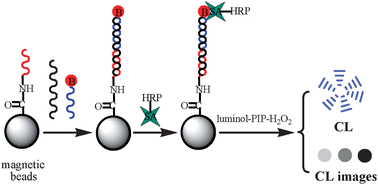Simple and sensitive chemiluminescence (CL) and CL imaging methods have been developed for the magnetic bead-based DNA hybridization assay. The assay relies on the high sensitivity and long stable light signal of the CL system in which horseradish peroxidase (HRP) catalyzes the luminol–H2O2 reaction with para-iodophenol (PIP) as the enhancer. In this protocol, a sandwich DNA hybridization is performed by mixing the target DNA with the magnetic bead-captured DNA and the biotinylated reporter DNA, followed through the biotin–streptavidin reaction with conjugated HRP, and then the conjugated HRP is determined by the CL system. The proposed CL protocol is suitable for for the detection of sequence-specific DNA related to the avian influenza A H1N1 virus at levels as low as 10 amol, and the CL imaging detection has a similar sensitivity. The sensitivities of the proposed methods with the HRP label are better than most of the metal nanoparticle-based methods, and are comparable with that of utilizing amplified techniques for DNA hybridization detection. In addition, the perfectly complementary DNA sequences and the single-base mismatched DNA sequences can be better distinguished by a thermally-stringent hybridization and washing steps. So, the proposed CL method can offer great promise for single-nucleotide polymorphism (SNP) analysis. Moreover, the proposed method may have significant potential for the simultaneous detection of various DNA sequences when different capture DNA sequences and reporter DNA sequences are used in a microarray.

You have access to this article
 Please wait while we load your content...
Something went wrong. Try again?
Please wait while we load your content...
Something went wrong. Try again?


 Please wait while we load your content...
Please wait while we load your content...